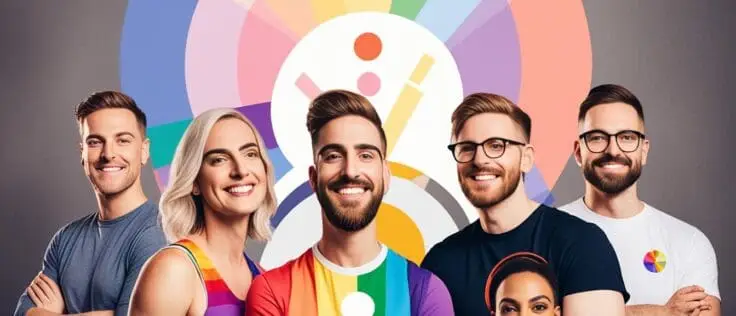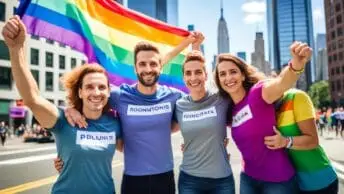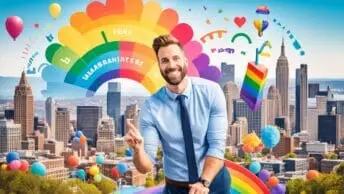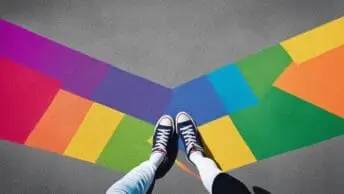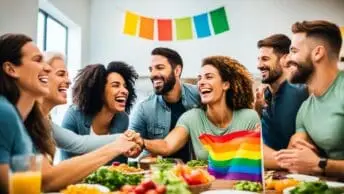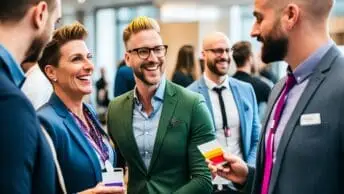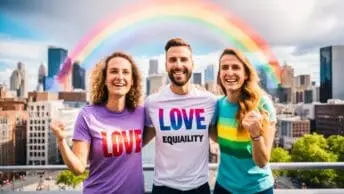Ever wondered why LGBTQ+ inclusivity goes beyond just sexual orientation? It’s a deep question.
Pride Month is celebrated every June. It remembers the Stonewall Uprising of 1969 in New York City. This event kick-started the modern LGBTQ+ movement. It symbolizes our fight for equality and recognition worldwide. Pride is more than a celebration; it’s a call to unity and awareness.
Embracing LGBTQ+ inclusivity means understanding the community’s diversity. Intersectionality is key here. It looks at how identity factors like race, disability, and gender shape lives.
Intersectionality shows us the extra struggles within the LGBTQ+ community. For example, in 2020, 24% of LGBTQ+ people of colour faced discrimination in healthcare. And, 90% of transgender people had healthcare delays. This shows why we must tackle these unique challenges.
By understanding intersectionality, we can celebrate the LGBTQ+ community’s diversity. This helps create fair and inclusive policies. It’s about recognising everyone’s unique story.
Importance of Intersectionality in the LGBTQ+ Community
Intersectionality is a concept that talks about how different forms of discrimination overlap for some people. Kimberlé Crenshaw introduced this idea. It shows that people facing multiple types of prejudice need special attention for fairness.
Looking at discrimination one issue at a time leaves some people out. For example, LGBTQ+ people might avoid doctors due to fear of homophobic or transphobic treatment. This can lead to poor health. Also, LGBTQ+ immigrants and asylum seekers struggle to find services that understand their culture or fear visa problems.
Seeing things through an intersectional view helps us see everyone’s different experiences. It helps make sure the most left-out people get what they need. This approach connects the LGBTQ+ cause with wider fights for justice. It encourages us to think about how various identities combine to affect someone’s life.
This way of thinking is key within the LGBTQ+ circle. It shows how race and gender biases affect people differently. Knowing this helps us fight against health inequalities. Studies show this, like research on sexual health in Latinas and substance use in diverse LGBTQ+ groups.
Lisa Bowleg says intersectionality is vital for public health. It helps us understand the complex needs of women and minorities better. By using this approach, the LGBTQ+ community moves closer to true inclusivity in fighting for justice.
Understanding Intersectionality
Kimberlé Crenshaw introduced the term intersectionality in 1989. It helps us see how race, gender, and income levels affect people. It’s key to understanding the unique challenges faced by queer people of colour, which are often missed.
The term “intersectionality” is now used in many academic areas. Marilyn Loden and Judy Rosener created the Diversity Wheel in 1990. It shows the many ways people and institutions can be diverse. In the UK, the Equality and Human Rights Commission uses intersectionality to monitor rights and equality.
Intersectionality isn’t just about understanding diversity. It shows us how different forms of inequality are connected. It’s more than adding oppressions together; it’s about seeing their intersections. This view helps create better policies for supporting marginalized communities.
Intersectionality shows we must look at how social categories and structural inequalities relate. For example, 44% of lesbian women face intimate partner violence, more than the 35% of heterosexual women. Women and girls with disabilities are also at higher risk. These facts show why an intersectional approach is vital in tackling social issues.
Seeing the overlap in various forms of oppression is critical. It matters not just for the LGBTQ+ community but for everyone. Embracing intersectionality moves us towards a society that includes and values everyone, especially queer people of colour.
Challenges Faced by LGBTQ+ Individuals of Colour
LGBTQ+ people of colour deal with many problems. These include homophobia, racism, and issues in getting good healthcare. Such challenges make them very vulnerable, especially regarding their mental health. They are more likely to have mental health issues than straight people. Racism and homophobia make it worse for people of colour in the LGBTQ+ community.
These individuals often face unfair treatment in healthcare. About 24% have faced discrimination when looking for medical help. This discrimination can lead to worse mental health, like depression and anxiety. Black LGBTQ+ people sometimes hide who they are to avoid judgement. This can increase their stress and mental health problems.
Money problems are also a big issue. LGBTQ+ people of colour often struggle more to get into college, find jobs, or get good housing compared to white LGBTQ+ people. Black people looking for therapy often find it hard to get appointments. This shows how big the problems with money and accessing help can be.
The idea of intersectionality is important to understand their struggles. LGBTQ+ youths of colour face a high risk of suicide and mental health issues. This is because they face many types of discrimination at once. We need to use education, advocacy, and empowerment to help. This can make society more welcoming for everyone.
We must focus on helping LGBTQ+ people of colour who face many challenges. This means making mental health resources that welcome everyone. We also need policies that stop discrimination in healthcare. Recognising these problems and pushing for supportive systems is crucial. It will help bring fairness for all in the LGBTQ+ community.
Challenges Faced by Disabled LGBTQ+ Individuals
Disabled LGBTQ+ folks face unique challenges caused by both ableism and heteronormativity. About 36% of LGBTQ+ adults say they have a disability, which is higher than the 24% of non-LGBTQ+ adults. This shows the added difficulties they face.
In the workplace, disabled people only hold 8% of managerial positions. They have to apply for 60% more jobs than those without disabilities. This struggle for employment affects their income, especially for trans individuals who are 15% more likely to earn under £20,000 annually than cisgender people.
When it comes to healthcare, 8% of LGBQ+ adults and 29% of transgender adults have been denied treatment because of who they are. There’s a lack of support within LGBTQ+ groups for disabled members. For instance, very few health insurance policies in the UK cover treatments for gender transitioning.
Ableism affects social inclusion for many in the LGBTQ+ community. Cognitive disabilities impact 25% of cisgender LGBQ+ adults and 35% of transgender adults. This is much higher compared to the 9% in non-LGBTQ+ adults, stressing the need for policies that recognise their complex identities.
In schools, 36% of disabled LGBTQ+ students face bullying because of their disability. Developing policies that consider both disabilities and LGBTQ+ identities is crucial. An education that challenges both discrimination and ableism is key to supporting disabled LGBTQ+ people and building a more inclusive society.
Challenges Faced by Transgender Individuals
Transgender individuals face unique challenges worsened by widespread transphobia and limited access to healthcare. Studies show many have trouble getting gender-affirming treatments. Reisner et al. (2016) highlighted the pressing health issues transgender people face, pointing out the need for better healthcare services.
Transgender women, particularly sex workers, have a high risk of getting HIV. Poteat et al. (2015) stressed the importance of preventive measures. According to Becasen et al. (2018), there’s a high HIV rate among the US transgender community from 2006-2017, showing a crucial need for specialized healthcare.
In 2016, NIMHD called sexual and gender minorities a health disparity group, noting the systemic unfairness faced by transgender people. Yet, there’s still a huge lack of suitable healthcare, partly because general doctors often don’t understand transgender issues (Keuroghlian et al., 2015). This leads to delays in getting the right treatments, causing mental health problems like anxiety and depression (Budge, Adelson, and Howard, 2013).
Research by Clements-Nolle, Marx, and Katz (2006) found discrimination and victimization link to higher suicide try rates in transgender folks. To solve these complex issues, there needs to be full education on transgender health, better treatment access, and stronger efforts to include and see transgender people in society.
Grossman et al. (2016) showed the sad truth of suicide among transgender youth, worsened by unsupportive environments. It’s vital to educate and raise awareness for transgender healthcare and rights, aiming for a community that welcomes and understands everyone.
Creating Safe Spaces and Inclusive Policies
Organisations must have effective diversity and inclusion practices. This creates a welcoming work environment. Research shows that Black people often don’t reach high-level jobs. They also get paid much less than White peers. Women with autism find job hunting hard because of gender norms.

McKinsey reports that many LGBTQ+ people feel alone at work. We need more LGBTQ+ support at work. Companies should fight unconscious bias and discrimination. For example, the B Impact Assessment supports fair work policies.
It’s crucial to have safe spots where workers can talk openly. Companies should understand everyone’s unique backgrounds. This helps fight bias and supports everyone better.
Tools like Develop Diverse fix bias in hiring ads. Training on understanding everyone’s different identities is important. Stonewall says fighting bias is key to help LGBTQIA+ people at work.
In the end, inclusive work policies do more than just hit diversity goals. They make a workplace truly welcoming. By considering everyone’s views and protecting everyone’s rights, companies can remove big obstacles. This ensures everyone has the same opportunities.
The Intersectionality of Race and Sexual Orientation/Gender Identity
When we talk about race, sexual orientation, and gender identity together, we uncover specific prejudices. These affect LGBTQ+ people of racial minorities deeply. They face discrimination that is both clear and hidden within LGBTQIA+ circles. This makes it vital to address these multiple forms of injustice directly.
Sessions that focus on this intersectionality have been really helpful. They get high ratings from most who attend. After these sessions, almost everyone feels more confident in understanding intersectionality.
Gerry Veenstra’s research in 2011 looked into health differences among queer people of colour using intersectionality theory. This study used the Canadian Community Health Survey, with over 90,000 people. It found that certain LGBTQIA+ groups reported worse health.
Educational efforts show good results, like increases in identifying healthcare barriers for SGM patients. It’s key to use these insights to promote racial justice in LGBTQIA+ areas. The complex links between race, gender, class, and sexual orientation mean addressing these is key for fair health care.저>
Fighting against these combined oppressions takes constant work. Some studies highlight the many challenges marginalized groups face. For truly inclusive LGBTQIA+ spaces, it’s important to embrace the diverse experiences of queer people of colour. This means breaking down barriers and building a supportive community.
The Intersectionality of Disability and Sexual Orientation/Gender Identity
Over a billion people, or 15% of the global population, have a disability, says the World Health Organization (WHO). Disabled LGBTQIA+ individuals face more challenges. This is due to the mix of their identities. They encounter discrimination and barriers, like verbal abuse and delayed treatment, from the health system. Such treatment not only limits their healthcare access but also lowers their self-esteem.
The Out of the Margins report reveals the extra hurdles faced by disabled individuals with diverse SOGIESC. Just three out of 12 groups focus on these people. This shows a clear lack of targeted support. These individuals often can’t access the services they need, especially in rural areas. This makes it crucial to include disability in wider social schemes.
Research shows that folks with disabilities experience obesity and smoking more. These health problems are usually ignored in the LGBTQIA+ community. This is due to the lack of inclusive health policies. Moreover, there’s generally more acceptance for disability over diverse genders and sexualities. This shows a need for more LGBTQIA+ rights advocacy.
The report finds most representation comes from these individuals joining SOGIESC groups, not disability groups. This indicates a missed chance for full inclusion. Developments and humanitarian agencies mostly work with disability rather than SOGIESC groups. This shows a need for better cooperation for wider support.
The report suggests building ties between disability and SOGIESC groups. This could improve inclusion and access to assistive technologies. Also, it’s vital to encourage inclusivity at the donor government level. This will help break down barriers for disabled LGBTQIA+ folks and protect their rights fully.
The Intersectionality of Gender Identity and Other Identities
Intersectionality looks at how different identities like gender, race, class, and disability mix. This idea came from Kimberlé Crenshaw in 1989. It shows how tough life can be for those with overlapping identities.

For those who are non-binary or gender non-conforming, understanding intersectionality is key. Their lives are shaped by how their gender identity and other aspects like ethnicity mix. For instance, transgender women of colour face more discrimination and violence, showing the importance of specific support.
To help transgender and non-binary people, we need to fight against multiple oppressions. By seeing how different systems of power connect, we can work towards fairer societies. Research helps us find ways to support diverse identities and push for changes in the system.
Boosting transgender visibility requires joining together for justice. We need to look at how power in organizations affects the disadvantaged. By lifting up transgender and non-binary voices and building strong support networks, we empower them.
Fostering Inclusivity Through Policies and Education
An inclusive environment is key and needs empathy, social justice, and learning about LGBTQIA+. Laws like the Autism Act 2009 and Equality Act 2010 help make schools welcoming for all. We must remember the importance of cultural understanding.
It takes a team of teachers, parents, and professionals to fully support students. Training for teachers is crucial so they can truly help every student. Talks and scholarships show us the way to make education fair for everyone.
Technology opens doors to make learning easier for everyone. It’s not just about gadgets but making sure all students can learn well. Inclusive classrooms celebrate different cultures, which teaches us empathy and understanding.
Students are unique, with different backgrounds and needs. We need to think about how their identities overlap and affect their schooling. Getting this right helps fight for fairness in schools, which is essential.
To break down barriers, inclusion must be part of all school policies. This requires everyone working together and being proactive in education changes. This way, we create a school culture that welcomes every student’s identity.
Conclusion
Understanding social identities and oppression in the LGBTQ+ community is key. Intersectionality helps us support equality and advocacy. It shows us everyone has many layers to their identity, like race and gender, and we need to understand these layers to fight discrimination.
Within the LGBTQ+ community, power and privilege can create extra hurdles for those with intersecting marginalised identities. To be fair to everyone, organisations must tackle these overlapping challenges. It’s crucial to work together and listen to those who are often left out.
To wrap it up, it’s essential to embrace an intersectional approach for LGBTQ+ equality and justice. By recognising the diverse identities within the community, we pave the way for better support. This article highlights the crucial role of intersectionality in ending unfair treatment for a brighter, fairer future.
